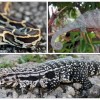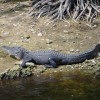 Captures and postmortem examinations, or necropsies, of invasive or nonnative animals may provide insight into the ecological impact of these invaders. Researchers should be able to perform necropsies when an opportunity arises to examine nonnative species for study. While the techniques described serve as a guide to necropsy of all reptiles, we focus on exotic species found in south Florida. South Florida provides prime habitat for invasive reptiles such as Argentine black and white tegu and Burmese python, and these species are used to describe our techniques. This 26-page fact sheet was written by Seth C. Farris, Michiko A. Squires, Frank Ridgley, Emma Lavergne, Mitchell Serota, and Frank J. Mazzotti, and published by the UF Department of Wildlife Ecology and Conservation, September 2013.
Captures and postmortem examinations, or necropsies, of invasive or nonnative animals may provide insight into the ecological impact of these invaders. Researchers should be able to perform necropsies when an opportunity arises to examine nonnative species for study. While the techniques described serve as a guide to necropsy of all reptiles, we focus on exotic species found in south Florida. South Florida provides prime habitat for invasive reptiles such as Argentine black and white tegu and Burmese python, and these species are used to describe our techniques. This 26-page fact sheet was written by Seth C. Farris, Michiko A. Squires, Frank Ridgley, Emma Lavergne, Mitchell Serota, and Frank J. Mazzotti, and published by the UF Department of Wildlife Ecology and Conservation, September 2013.
http://edis.ifas.ufl.edu/uw382
Tag: Michiko A. Squires
Native and Nonnative Crocodilians of Florida
 Florida has two native species of crocodilians, the American alligator and the American crocodile. These federally protected species are easily confused with nonnative crocodilians found in south Florida, such as the spectacled caiman and the Nile crocodile. Some key features used to distinguish these animals are the shape of the head, the shape of the snout, and the pattern of nuchal scutes (bony plates in between head and shoulders). It is important to report all nonnative crocodilians so that researchers may quickly remove them in order to protect Florida’s native ecosystems. This 2-page fact sheet was written by Michiko A. Squires, Seth C. Farris, Brian M. Jeffery, and Frank J. Mazzotti, and published by the UF Department of Wildlife Ecology and Conservation, September 2013.
Florida has two native species of crocodilians, the American alligator and the American crocodile. These federally protected species are easily confused with nonnative crocodilians found in south Florida, such as the spectacled caiman and the Nile crocodile. Some key features used to distinguish these animals are the shape of the head, the shape of the snout, and the pattern of nuchal scutes (bony plates in between head and shoulders). It is important to report all nonnative crocodilians so that researchers may quickly remove them in order to protect Florida’s native ecosystems. This 2-page fact sheet was written by Michiko A. Squires, Seth C. Farris, Brian M. Jeffery, and Frank J. Mazzotti, and published by the UF Department of Wildlife Ecology and Conservation, September 2013.
http://edis.ifas.ufl.edu/uw380